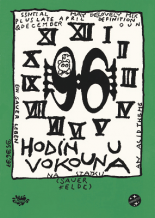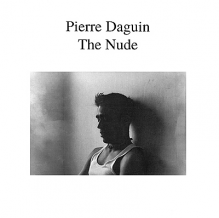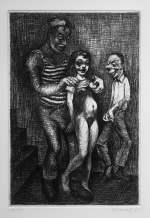| Umělec magazine 2002/3 >> The German Corner | List of all editions. | ||||||||||||
|
|||||||||||||
The German CornerUmělec magazine 2002/301.03.2002 Klaus Gallwitz | reviews | en cs |
|||||||||||||
|
"The German Corner; Heather Allen, Susanne Britz,
Filipa Cesar, Koscheisen & Hullman, Zoltan Laszlo, Bernd Mechler, Jiří Surůvka, Barbara Willie, Simone Zaugg; Václav Špála Gallery, Prague, 26 June–31 August, 2002 German Corner is Germany’s very popular tourist destination. It lies in the city of Koblenz and is a peninsula where the rivers Rhine and Mosel merge. The place owes its fame to a colossal riding statue of the first German emperor Wilhelm I, a memorial to the nation’s unification in the 19th century. A group of artists in residence at the Balmoral Castle in Bad Ems, near Koblenz, self-organized an exhibition, named after this tourist attraction, at Václav Špála Gallery in Prague, in mid-June, 2002. But with five of the ten artists being from other countries, the exhibition didn’t show any specific “German” art. The others came from Switzerland, England, Rumania, Portugal and the Czech Republic. The latter is also the home country of the initiator of the entire project, artist Jiří Surůvka, who allowed the ten artists to be their own curators. They decided on the layout of the exhibition in the two-story gallery, whose space turned out to be most helpful for the exhibition. The individual, extremely different media and content of the works corresponded in many ways. The show even gave an impression of being an almost surreal event, comprised as it was of a pencil and photograph, a broom and palette, soundtracks and handwork, video and canvas, oil colors and a chair. The inspired set proved its added value by exceeding the sum of the individual contributions and fitting the exhibition with an unexpected side effect: a spinning stage with repeating motifs. The exhibition was based on the effective quality of delay and the repetition of some of the works. Everybody Loves Crime, a video by Swiss artist Simone Zaugg unwittingly became the motto for the mutual relationships of the works and ambiguity of perception in artistic and everyday lives. Zaugg combined banal motifs with media-charged content, which she suddenly interrupted with short interventions in the plot, opening new levels of perception. In a video performance, Heather Allen attemtped to slip into a pink latex miniskirt. Much like art and life, it just didn’t quite fit. With endurance and patience she went on shoving her body into the skirt for 22 minutes; the torturous bit was trying to edge it over her hips. No new strategies helped to defeat the insidious object, only a very specific type of self-irony. Barbara Wille invited visitors into her imaginary salon, which she had turned into a smoking lobby furnished with a chair and a table with holes drilled in it. Dozens of lit cigarettes smoldered there. At first it seemed that painter Bernd Mechler, with his conventionally made canvas paintings, had came in order to help Wille create the right lounge atmosphere. Like cigarette smoke, his curves, twists and shading connected the beginning and the end, light and dark, space and surface. But actually the works broke away from their surroundings and remained distant. Susanne Britz illuminated the exceptional “memory” in her drawings on small and large-sized sheets of paper, forming a bridge between the inner and external worlds. Dialectics, both in images and in concepts, was the basis for parallel works by the artistic duo Koscheisen and Hullmann. Their visible but unuttered difference underlined the same and seemingly unambiguous motif. The smallest contribution, taking up only a few square centimeters, was made by Filipa Cesar. Her work pointed to the insoluble contradiction between feelings and their marketability. She used the common red dots used in galleries to signify that a work of art has been sold to formed the word “soul” on one wall. Jiří Surůvka presented contrasting colorful souvenirs from Bad Ems where he took pictures of cemeteries and memorials — among them the German Corner — as a model of love for order and flaunted piety. When the exhibition installation was finished, it was Zoltan Laszlo’s turn. He had come to survey the situation for his subversive work in the window of the gallery, which connected the facade and the exhibition hall and the arrow in the logo of the gallery’s sponsor, Škoda Auto, and the unsponsored ferment movement of the exhibited works. He called it Icarus — an invasion of art into reality, spanning the two stories of the gallery and out into the street. Dear Art Lovers and Colleagues, I would like to share with you the disappointment and anger that I felt after taking part in an exhibition at the Václav Špála Gallery. It concerns a scandal that damages the ethics of our profession and against which I strongly protest. I was a participating artist in the group exhibition Deutsches Eck and installed a work in the gallery window. This work was formally concerned with the Škoda logo, and showed, as part of the installation, the transformation of this symbol into an Icarus. After the opening this work was removed without my permission on the instruction of the gallery director in order to avoid a confrontation with Škoda, the sponsors of the gallery. This was an act of disrespect and a lack of solidarity for colleagues, it took place behind my back and was unfair. The content and meaning of the work was not solely political and was in no way a protest against Škoda. It was far more an argument about the profession of the artist (hence the logo’s transformation into a paint palette) in the context of support for art. Yours sincerely, Zoltan Laszlo Laszloo@yahoo.com "
01.03.2002
Recommended articles
|
|||||||||||||
|
04.02.2020 10:17
Letošní 50. ročník Art Basel přilákal celkem 93 000 návštěvníků a sběratelů z 80 zemí světa. 290 prémiových galerií představilo umělecká díla od počátku 20. století až po současnost. Hlavní sektor přehlídky, tradičně v prvním patře výstavního prostoru, představil 232 předních galerií z celého světa nabízející umění nejvyšší kvality. Veletrh ukázal vzestupný trend prodeje prostřednictvím galerií jak soukromým sbírkám, tak i institucím. Kromě hlavního veletrhu stály za návštěvu i ty přidružené: Volta, Liste a Photo Basel, k tomu doprovodné programy a výstavy v místních institucích, které kvalitou daleko přesahují hranice města tj. Kunsthalle Basel, Kunstmuseum, Tinguely muzeum nebo Fondation Beyeler.
|




































 New book by I.M.Jirous in English at our online bookshop.
New book by I.M.Jirous in English at our online bookshop.
Comments
There are currently no comments.Add new comment